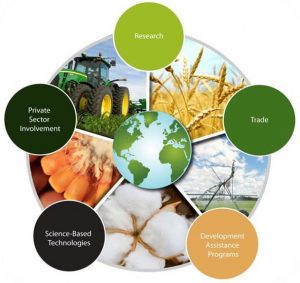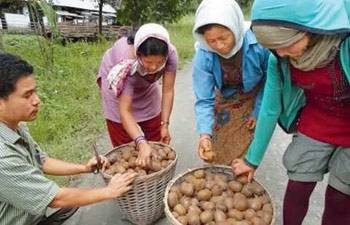Entrepreneurial opportunities in agribusiness
 India is an agricultural country. The land is best suited for agriculture because of its fertility and the climatic conditions. Agriculture is the backbone of Indian economy. The growth in the agricultural sector has made a large impact on generating revenue from the rest of the world. However, storage has always been a big problem; the gap between the produce and storage is simply too wide. Quality production and enhancing storage capacity are all long-term goals of the nation. The solution in storage will reduce the wastage of grains and vegetables.
India is an agricultural country. The land is best suited for agriculture because of its fertility and the climatic conditions. Agriculture is the backbone of Indian economy. The growth in the agricultural sector has made a large impact on generating revenue from the rest of the world. However, storage has always been a big problem; the gap between the produce and storage is simply too wide. Quality production and enhancing storage capacity are all long-term goals of the nation. The solution in storage will reduce the wastage of grains and vegetables.
When each year some state in the country fears drought on one hand, on the other hand, Food Corporation of India loses tonnes of grains brazenly. It is reported that the country lost more than 40,000 tonnes in past two years due to natural calamities like cyclone and floods, experts say it is also an indication of poor storage facilities, pilferage and transit loss.
Food and food grain worth nearly Rs.50,000 crores is lost every year. More specifically, nearly 30% of the country’s fruits and vegetables are lost due to lack of cold-storage facilities, and more than 30% of grains supplied through the public distribution system are lost because of storage constraints. As much as 1, 94,502 metric tonnes of food grain worth crores of rupees are wasted in India due to various reasons. The Food Corporation of India (FCI) has given this information in reply to an RTI query sought by an activist Mr. Om Prakash Sharma. This happens because of lack of proper cold stores and corrupt middlemen, who are also responsible for increasing the prices of vegetables, hoarding and lack of government spirit to bring in scientific systems.
The inadequacy of government operated storage is often cited in the media as a major cause of food waste in the country. The Food Corporation of India has little modern storage such as grain silos, and instead maintains its stock of grains in outdoor depots scattered throughout the country. The government-run grain storage compounds are pathetic; warehouses are 20 foot stacks of 50kg burlap sacks sitting in parking lots and covered with plastic tarps to keep out the rain. This is a common scene in Punjab, Haryana, Andhra Pradesh and many other states. Most facilities are open air and offer no protection from humidity, birds or pests. In many cases, the tarps don’t even fully cover the grain, which rotten the grain depots after being hit by an unexpected rainstorm.
 Experts estimate that as much as 20% of the grain stored in these conditions goes to waste. The absolute wastage is worst in recent years when free market prices collapse and the government is forced to buy excess supply at the minimum support price.
Experts estimate that as much as 20% of the grain stored in these conditions goes to waste. The absolute wastage is worst in recent years when free market prices collapse and the government is forced to buy excess supply at the minimum support price.
The entire food chain requires modernization and the production is expected to be doubled in the coming 10 years. Apart from domestic demand, this industry brings in huge export prospects. At present agri-business may involve either an input or a product or service which encompasses items such as Productive resources (feed, seed, fertilizer, equipment, energy, pesticides, machinery, etc.), agricultural commodities (raw and processed commodities of food and fiber) and facilitative services (credit, insurance, marketing, storage, processing, transportation, packing, distribution, consultancy, soil testing etc.).
Most of the agricultural infrastructure can be built on public-private partnership model to improve storage facilities is a promising solution, and additional deals are in the works. Infrastructure investments would include distribution, quality control, manufacturing, food processing, quality control, storage and warehousing, logistics, packaging and many more.
The main objectives of the Agricultural Infrastructure Development Project are to 1) develop land and water resources for the purposes of increasing farmers’ incomes and protecting the environment through land terracing and harvesting of runoff water in small hill ponds 2) increase access to and from isolated rural areas through the construction of agricultural roads and 3) strengthen the institutional and implementation capabilities of the Green Plan and the Directorate of Studies and Coordination within the Ministry of Agriculture by upgrading their human and material capabilities, financing the conduct of a National Agricultural Census and establishing an Information Management System to provide the data necessary for strategy and policy formulation.
In the private sector agriculture infrastructure companies are the in thing that aims at addressing the needs of the farming communities for farm services and agricultural infrastructure. These companies offer collateral management, grading facility to farmers who can get 15-25 per cent value addition on their crops. There is a huge opportunity in this sector. Farmers need both front-end and back-end infrastructural facilities.
 The post-harvest ecosystem is very diverse, and hence has several players like SLCM (Sohanlal Commodity Management Pvt Ltd), Star Agri-warehousing and Collateral Management, Origo India which is a complete post-harvest management services for agricultural commodities, and Gramco Infratech Pvt. Ltd which is an answer to the farmers needs for modern and efficient agriculture. These and many other companies have created a platform and network of infrastructure for framers. More players are entering the market and attracting investors to pump in capital in the under-developed agricultural storage and cold chain industry in India that is hyped as the next big thing and expected to contribute to long-term gains as retail demand and consumption pick up in smaller cities and towns across the country.
The post-harvest ecosystem is very diverse, and hence has several players like SLCM (Sohanlal Commodity Management Pvt Ltd), Star Agri-warehousing and Collateral Management, Origo India which is a complete post-harvest management services for agricultural commodities, and Gramco Infratech Pvt. Ltd which is an answer to the farmers needs for modern and efficient agriculture. These and many other companies have created a platform and network of infrastructure for framers. More players are entering the market and attracting investors to pump in capital in the under-developed agricultural storage and cold chain industry in India that is hyped as the next big thing and expected to contribute to long-term gains as retail demand and consumption pick up in smaller cities and towns across the country.
The government of India has legislated 100% Foreign Direct Investment in the agricultural sector. This has given a huge boost because investors from foreign countries are provided with a direct route for investing in agricultural warehousing, which would also include investing on cold storage. Similarly, 100% FDI also offers an automatic route for foreign companies who specialize in the development of seeds and other agricultural produce.
The Department of Agriculture and Cooperation is mainly responsible for foreseeing the optimized utilization of soil, water, land, and other natural resources related to agriculture. The department is headed by the Ministry of Agriculture, and is responsible for initiating policies and programs to push growth in the agriculture industry of India.
Currently, there is indeed a dearth of warehouses in India, especially in the agriculture sector. For a country which is primarily an agrarian economy, there is immense potential in the agri-logistics and cold chain industry. In fact, seeing this, risk capital investors such as private equity and venture capital funds are betting big on the business opportunity that the sector has to offer in the long run. There is a significant investor interest in niche segments like cold chain, agri-logistics, and warehousing within the logistics sector. However, there’s need for integrated infrastructure and agri policies, which could lead to more warehouses in the country.
 The good news is that there are quite a few private equity (PE) deals in advanced stages of discussion. For instance, ColdEX Logistics, a cold chain company that provides support and distribution services to well-known international brands including Burger King and Starbucks, is expanding its operations. Investments are pouring in this sector. Since 2012, PE investors have infused around $275 million in the sector, according to research firm Venture Intelligence. Recently, Canadian investment giant Fairfax invested $126 million in National Collateral Management Services, a private-sector agricultural commodities Storage Company headquartered in Gurgaon.
The good news is that there are quite a few private equity (PE) deals in advanced stages of discussion. For instance, ColdEX Logistics, a cold chain company that provides support and distribution services to well-known international brands including Burger King and Starbucks, is expanding its operations. Investments are pouring in this sector. Since 2012, PE investors have infused around $275 million in the sector, according to research firm Venture Intelligence. Recently, Canadian investment giant Fairfax invested $126 million in National Collateral Management Services, a private-sector agricultural commodities Storage Company headquartered in Gurgaon.
Indian cold chain industry is growing annually at 28% the total value of cold chain industry in India is expected to reach USD 13 billion by 2017 through increased investments, modernization of existing facilities, and establishment of new ventures via private and government partnerships. India’s cold chain industry is still evolving. The Indian cold chain market is highly fragmented with more than 3,500 companies in the whole value system. It has tremendous scope because 11% of world’s total vegetables production is accounted by India. 127 Million Tonnes of milk was produced in 2011- 12, but cold storage capacity is only available for 70,000-80,000 Tonnes of milk. Fish production is wasted to a big extent due to lack of cold storage.
There is a big scope for new ventures in Indian agri-business and it has a promising future.












































